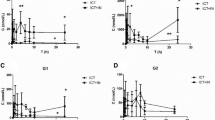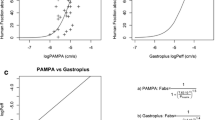Abstract
Although arctigenin (AR) has attracted substantial research interests due to its promising and diverse therapeutic effects, studies regarding its biotransformation were limited. The current study aims to provide information regarding the pharmacokinetic properties of AR via various in vitro and in vivo experiments as well as semi-mechanistic pharmacokinetic modeling. Our in vitro rat microsome incubation studies revealed that glucuronidation was the main intestinal and liver metabolic pathway of AR, which occurred with V max, K m, and Clint of 47.5 ± 3.4 nmol/min/mg, 204 ± 22 μM, and 233 ± 9 μl/min/mg with intestinal microsomes and 2.92 ± 0.07 nmol/min/mg, 22.7 ± 1.2 μM, and 129 ± 4 μl/min/mg with liver microsomes, respectively. In addition, demethylation and hydrolysis of AR occurred with liver microsomes but not with intestinal microsomes. In vitro incubation of AR and its metabolites in intestinal content demonstrated that glucuronides of AR excreted in bile could be further hydrolyzed back to the parent compound, suggesting its potential enterohepatic circulation. Furthermore, rapid formation followed by fast elimination of arctigenic acid (AA) and arctigenin-4′-O-glucuronide (AG) was observed after both intravenous (IV) and oral administrations of AR in rats. Linear pharmacokinetics was observed at three different doses for AR, AA, and AG after IV administration of AR (0.48–2.4 mg/kg, r 2 > 0.99). Finally, an integrated semi-mechanistic pharmacokinetic model using in vitro enzyme kinetic and in vivo pharmacokinetic parameters was successfully developed to describe plasma concentrations of AR, AA, and AG after both IV and oral administration of AR at all tested doses.







Similar content being viewed by others
References
Kim Y, Hollenbaugh JA, Kim DH, Kim B. Novel PI3K/Akt inhibitors screened by the cytoprotective function of human immunodeficiency virus type 1 Tat. PLOS One. 2011;6. doi 10.1371/journal.pone.0021781.
Yang Z, Liu N, Huang B, Wang Y, Hu Y, Zhu Y. Effect of anti-influenza virus of arctigenin in vivo. Zhongyaocai. 2005;28:1012–4.
Hayashi K, Narutaki K, Nagaoka Y, Hayashi T, Uesato S. Therapeutic effect of arctiin and arctigenin in immunocompetent and immunocompromised mice infected with influenza A virus. Biol Pharm Bull. 2010;33:1199–205.
Kou XJ, Qi SM, Dai WX, Luo L, Yin ZM. Arctigenin inhibits lipopolysaccharide-induced iNOS expression in RAW264.7 cells through suppressing JAK-STAT signal pathway. Int Immunopharmacol. 2011;11:1095–102.
Tsai WJ, Chang CT, Wang GJ, Lee TH, Chang SF, Lu SC, et al. Arctigenin from Arctium lappa inhibits interleukin-2 and interferon gene expression in primary human T lymphocytes. Chin Med. 2011;6. doi 10.1186/1749-8546-6-12.
Hyam SR, Lee IA, Gu W, Kim KA, Jeong JJ, Jang SE, et al. Arctigenin ameliorates inflammation in vitro and in vivo by inhibiting the PI3K/AKT pathway and polarizing M1 macrophages to M2-like macrophages. Eur J Pharmacol. 2013;708:21–9. doi:10.1016/j.ejphar.2013.01.014.
Cho MK, Jang YP, Kim YC, Kim SG. Arctigenin, a phenylpropanoid dibenzylbutyrolactone lignan, inhibits MAP kinases and AP-1 activation via potent MKK inhibition: the role in TNF-alpha inhibition. Int Immunopharmacol. 2004;4:1419–29. doi:10.1016/j.intimp.2004.06.011.
Zhu Z, Yan J, Jiang W, Yao X-g, Chen J, Chen L, et al. Arctigenin effectively ameliorates memory impairment in Alzheimer’s disease model mice targeting both beta-amyloid production and clearance. J Neurosci. 2013;33:13138–49. doi:10.1523/JNEUROSCI.4790-12.2013.
Strimpakos AS, Saif MW. Update on phase I studies in advanced pancreatic adenocarcinoma. Hunting in darkness. JOP. 2013;14:354–8. doi:10.6092/1590-8577/1664.
Kang K, Lee HJ, Kim CY, Lee SB, Tunsag J, Batsuren D, et al. The chemopreventive effects of Saussurea salicifolia through induction of apoptosis and phase II detoxification enzyme. Biol Pharm Bull. 2007;30:2352–9.
Wang L, Zhao F, Liu K. Induction of apoptosis of the human leukemia cells by arctigenin and its mechanism of action. Chin J Chem. 2008;43:542–7.
Hsieh CJ, Kuo PL, Hsu YC, Huang YF, Tsai EM, Hsu YL. Arctigenin, a dietary phytoestrogen, induces apoptosis of estrogen receptor-negative breast cancer cells through the ROS/p38 MAPK pathway and epigenetic regulation. Free Radic Biol Med. 2013;67C:159–70. doi:10.1016/j.freeradbiomed.2013.10.004.
Awale S, Lu J, Kalauni SK, Kurashima Y, Tezuka Y, Kadota S, et al. Identification of arctigenin as an antitumor agent having the ability to eliminate the tolerance of cancer cells to nutrient starvation. Cancer Res. 2006;66:1751–7. doi:10.1158/0008-5472.Can-05-3143.
Susanti S, Iwasaki H, Inafuku M, Taira N, Oku H. Mechanism of arctigenin-mediated specific cytotoxicity against human lung adenocarcinoma cell lines. Phytomedicine. 2013;21:39–46. doi:10.1016/j.phymed.2013.08.003.
Gu Y, Scheuer C, Feng D, Menger MD, Laschke MW. Inhibition of angiogenesis: a novel antitumor mechanism of the herbal compound arctigenin. Anticancer Drugs. 2013;24:781–91. doi:10.1097/CAD.0b013e328362fb84.
Shoeb M, Celik S, Jaspars M, Kumarasamy Y, MacManus SM, Nahar L, et al. Isolation, structure elucidation and bioactivity of schischkiniin, a unique indole alkaloid from the seeds of Centaurea schischkinii. Tetrahedron. 2005;61:9001–6. doi:10.1016/j.tet.2005.07.047.
Yao X, Zhu F, Zhao Z, Liu C, Luo L, Yin Z. Arctigenin enhances chemosensitivity of cancer cells to cisplatin through inhibition of the STAT3 signaling pathway. J Cell Biochem. 2011;112:2837–49. doi:10.1002/jcb.23198.
Hq W, Jj J, Wang J. Arctigenin enhances chemosensitivity to cisplatin in human nonsmall lung cancer H460 cells through downregulation of survivin expression. J Biochem Mol Toxicol. 2013;28:39–45.
Kasper R, Gansser D, Doehmer J. Biotransformation of the naturally-occurring lignan (−)-arctigenin in mammalian-cell lines genetically-engineered for expression of single cytochrome-P450 isoforms. Planta Med. 1994;60:441–4.
Zhao YF, Song FR, Zhao LP, Liu SY. Studies on the biotransformation of arctigenin using electrospray ionization mass spectrometry. Chin J Chem. 2009;67:1123–6.
Heinonen S, Nurmi T, Liukkonen K, Poutanen K, Wahala K, Deyama T, et al. In vitro metabolism of plant lignans: new precursors of mammalian lignans enterolactone and enterodiol. J Agric Food Chem. 2001;49:3178–86. doi:10.1021/Jf010038a.
Gao Q, Zhang Y, Wo S, Zuo Z. Extensive intestinal first-pass metabolism of arctigenin: evidenced by simultaneous monitoring of both parent drug and its major metabolites. J Pharm Biomed Anal. 2014;91:60–7. doi:10.1016/j.jpba.2013.12.017.
Gao Q, Zhang Y, Wo S, Zuo Z. Hydrolysis is the dominating in vivo metabolism pathway for arctigenin: identification of novel metabolites of arctigenin by LC/MS/MS after oral administration in rats. Planta Med. 2013;79:471–9. doi:10.1055/s-0032-1328332.
Zhao D, Zhang Y, Xu C, Dong C, Lin H, Zhang L, et al. Pharmacokinetics, tissue distribution, and plasma protein binding study of platinum originating from dicycloplatin, a novel antitumor supramolecule, in rats and dogs by ICP-MS. Biol Trace Elem Res. 2012;148:203–8. doi:10.1007/s12011-012-9364-2.
Zou Q, Gu Y, Lu R, Zhang T, Zhao GR, Liu C, et al. Development of an LC/MS/MS method in order to determine arctigenin in rat plasma: its application to a pharmacokinetic study. Biomed Chromatogr. 2013;27:1123–8. doi:10.1002/bmc.2916.
He F, Dou DQ, Hou Q, Sun Y, Kang TG. Pharmacokinetic study of arctigenin in rat plasma and organ tissue by RP-HPLC method. Nat Prod Res. 2013;27:903–6. doi:10.1080/14786419.2012.666745.
Zhang L, Li C, Lin G, Krajcsi P, Zuo Z. Hepatic metabolism and disposition of baicalein via the coupling of conjugation enzymes and transporters—in vitro and in vivo evidences. AAPS J. 2011;13:378–89. doi:10.1208/s12248-011-9277-6.
Sagert KB. In: Zhang Y, editor. United States Pharmacopeia and National Formulary (USP-NF). Thousand Oaks: SAGE Publications; 2008.
Akao T, Kawabata K, Yanagisawa E, Ishihara K, Mizuhara Y, Wakui Y, et al. Baicalin, the predominant flavone glucuronide of scutellariae radix, is absorbed from the rat gastrointestinal tract as the aglycone and restored to its original form. J Pharm Pharmacol. 2000;52:1563–8.
FDA. Guidance for industry, bioanalytical method validation. US Food and Drug Administration, Centre for Drug Evaluation and Research, Rockville2001.
Martignoni M, Groothuis G, de Kanter R. Comparison of mouse and rat cytochrome P450-mediated metabolism in liver and intestine. Drug Metab Dispos. 2006;34:1047–54. doi:10.1124/dmd.105.009035.
Miller DL. Rat small intestine—development, composition and effects of perfusion. Am J Dig Dis. 1971;16:247. doi:10.1007/Bf02235247.
Kwon Y. Handbook of essential pharmacokinetics, pharmacodynamics and drug metabolism for industrial scientists: Springer; 2002. 277 p.
Gardiner P, Paine SW. The impact of hepatic uptake on the pharmacokinetics of organic anions. Drug Metab Dispos. 2011;39:1930–8. doi:10.1124/dmd.111.039842.
Teiber JF, Billecke SS, La Du BN, Draganov DI. Estrogen esters as substrates for human paraoxonases. Arch Biochem Biophys. 2007;461:24–9. doi:10.1016/j.abb.2007.02.015.
Teiber JF, Draganov DI, La Du BN. Lactonase and lactonizing activities of human serum paraoxonase (PON1) and rabbit serum PON3. Biochem Pharmacol. 2003;66:887–96.
Syvanen S, Schenke M, van den Berg DJ, Voskuyl RA, de Lange EC. Alteration in P-glycoprotein functionality affects intrabrain distribution of quinidine more than brain entry—a study in rats subjected to status epilepticus by Kainate. AAPS J. 2012;14:87–96. doi:10.1208/s12248-011-9318-1.
Johansson CC, Gennemark P, Artursson P, Abelo A, Ashton M, Jansson-Lofmark R. Population pharmacokinetic modeling and deconvolution of enantioselective absorption of eflornithine in the rat. J Pharmacokinet Pharmacodyn. 2013;40:117–28. doi:10.1007/s10928-012-9293-x.
Setchell KD. Phytoestrogens: the biochemistry, physiology, and implications for human health of soy isoflavones. Am J Clin Nutr. 1998;68:1333–46.
Moon YJ, Sagawa K, Frederick K, Zhang S, Morris ME. Pharmacokinetics and bioavailability of the isoflavone biochanin A in rats. AAPS J. 2006;8:433–42. doi:10.1208/aapsj080351.
Chen J, Lin H, Hu M. Metabolism of flavonoids via enteric recycling: role of intestinal disposition. J Pharmacol Exp Ther. 2003;304:1228–35. doi:10.1124/jpet.102.046409.
Glitso LV, Mazur WM, Adlercreutz H, Wahala K, Makela T, Sandstrom B, et al. Intestinal metabolism of rye lignans in pigs. Br J Nutr. 2000;84:429–37.
ACKNOWLEDGMENTS
This work is supported by Direct Grant 3800005 from the Chinese University of Hong Kong and research fund 7010213 from the Health Authority of Hong Kong.
Author information
Authors and Affiliations
Corresponding author
Electronic supplementary material
Below is the link to the electronic supplementary material.
ESM 1
(DOCX 23.4 kb)
Rights and permissions
About this article
Cite this article
Gao, Q., Zhang, Y., Wo, S. et al. Elucidation of Arctigenin Pharmacokinetics After Intravenous and Oral Administrations in Rats: Integration of In Vitro and In Vivo Findings via Semi-mechanistic Pharmacokinetic Modeling. AAPS J 16, 1321–1333 (2014). https://doi.org/10.1208/s12248-014-9664-x
Received:
Accepted:
Published:
Issue Date:
DOI: https://doi.org/10.1208/s12248-014-9664-x




